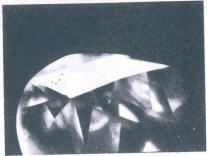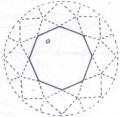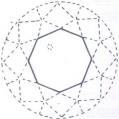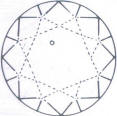 For the novice in the use of the loupe or a microscope
it is sometime a problem how to distinguish between surface dirt or
internal defects. Is there a minute light particle of dust on the
surface of a facet or is it a small internal inclusion? Is the fine
light line a scratch on the surface, maybe a polishing mark or a small
crack in the stone which influences the clarity? The answer is easily
found by adjusting the table and all other facets of a cut diamond by
rotation of movement of the stone towards the light source, so that the
light is totally reflected on the surface and makes it appear white and
non-transparent. Indirect light all surface marks are then seen as dark
outlines (Fig 169).
For the novice in the use of the loupe or a microscope
it is sometime a problem how to distinguish between surface dirt or
internal defects. Is there a minute light particle of dust on the
surface of a facet or is it a small internal inclusion? Is the fine
light line a scratch on the surface, maybe a polishing mark or a small
crack in the stone which influences the clarity? The answer is easily
found by adjusting the table and all other facets of a cut diamond by
rotation of movement of the stone towards the light source, so that the
light is totally reflected on the surface and makes it appear white and
non-transparent. Indirect light all surface marks are then seen as dark
outlines (Fig 169).
Does the feature appear even and uniformly "closed", it is a defect beneath the facet, i.e. an inclusion.
Another method of differentiating is:
Using high magnification (low resolution) one focuses exactly onto a
facet edge, for instance the table edge. If the doubtful matter appears
sharp in focus, it lies on the same level as the table plane, and it
therefore is a surface feature (Fig 170a).
If the table edges are sharply in focus, but the feature in question appears indistinct and only becomes clearly defined when the microscope tube is lowered, it can be taken as proof that it is indeed an internal inclusion (Fig 170 b and c) at a lower position than the table plane.
 a |
 b |
 c |
| Fig 170a-c The depth of an Inclusion can be ascertained by focusing | ||
Surface feature can be removed with a pointed pen, the point of a needle or a fine splinter of wood.
Grading for clarity in fancy cuts is more difficult than in brilliants because the reflections of the facets or of the girdle are irregular, are concentrated in the culets of navettes, drops or heart-shapes as well as in the girdle zones of an emerald cut stone and thus tend to "over reflect" small inclusions (Fig 171). It is therefore essential that these zones are especially carefully examined.
 |
 |
| Fig 171 Fancy cuts must be especially closely examined on the points which collect the reflections | |
| The technique of microscopy | Reflected inclusions |